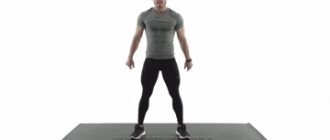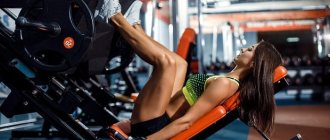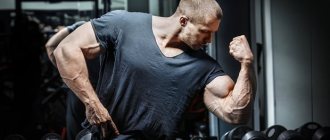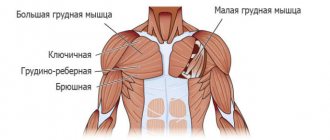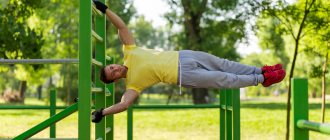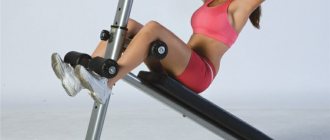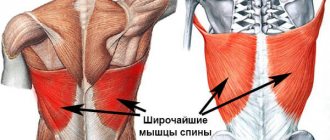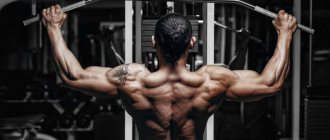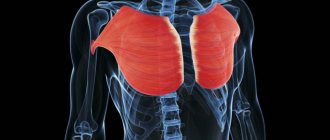Not muscles, but “mountain”? In fact, this is the reality for every bodybuilder. This very reality is called pumping. The bottom line is that in the process of performing special exercises, certain muscles are visually pumped. They acquire super-volume, which lasts for 20-30 minutes (sometimes up to 1 hour). Bodybuilders most often resort to pumping before going out in public. Pumping does not provide enormous strength and endurance, but it looks great. Pumping has no gender restrictions - it is used simultaneously by representatives of the strong and weak half of humanity.
The best training programs for pumping muscles
There are several programs for pumping different muscle groups and areas of the body (types of pumping training). They were compiled by experienced trainers using personal trial and error. The complex must be carried out strictly according to plan in order to achieve visible and desired results. The effect is visible after the first lesson. Over time, the pumping effect will last longer. The muscles will remember this feeling and try to maintain it.
What is pumping?
Pumping is a sudden rush of blood to the trained muscle, during which a feeling of “expanding” of the muscle and a strong burning sensation is formed in it. This occurs due to increased pressure in muscle cells and blood vessels.
This sensation is achieved by repeating the same movement over and over again for a certain period of time (from several seconds to minutes). When talking about pumping in women's training, I will mean training with your own weight or training with light weights. We'll probably leave pumping training
So, we found out how pumping occurs inside : blood flows to the muscles, which is why they increase in volume. And now I will try to visually describe how pumping occurs from the outside .
achieve the pumping effect with the most common exercises performed at a shortened amplitude. The shortened amplitude of any exercise is ½-¼ of the full-amplitude movement.
Let's look at the example of squats.
Full amplitude is deep squats to the very bottom. The picture below shows the stages of this exercise.
A shortened amplitude (pumping) is a delay at the bottom point of the exercise and performing several repetitions of the same movement (squats) over and over again without stopping and lifting the pelvis up to the starting position (A). These movements are similar to the small-amplitude springs that we do while sitting below (stages B, C and D are repeated several cycles in a row).
Due to such shortened movements (springs), the muscle is pumped, during which the muscle is filled with blood, the release of anabolic hormones (self-tropin and testosterone) increases, and the process of fat burning occurs many times faster. Therefore, using the principle of pumping in their training, girls can significantly accelerate the positive results from them.
Pumping the pectoral muscles
Includes:
- bench press in a lying position;
- butterfly;
- bent over dumbbell flyes;
- Bent-over dumbbell press;
- pullover,
- information in the crossover through the lower blocks.
You need to perform the exercises using trisets, for example – bench press, butterfly and pullover, the second option – bent over dumbbell press, bent over dumbbell flyes, crossover exercises through lower blocks. This means alternating exercises, performing them one after another without rest breaks. This rather heavy type of pumping, such as negatives, is also very suitable for the chest. The bottom line is that you first need to isolate the muscle, then pump it well. An example would be to perform the butterfly exercise - since it is isolating, and then do the base - the bench press. You need to start with 3 sets of 10-15 repetitions. Over time, it is imperative to increase the number of approaches and repetitions. After a month there should be at least 6 approaches for the pumping to be noticeable. Exercises can be performed using various pumping techniques. The main thing is to gradually increase the number of repetitions without fail.
Pros and cons of pumping
Advantages:
- Pumping does not imply the use of maximum weights. Ligaments and joints are not overloaded during the “saving” mode.
- Since the work is carried out mainly with light weights, the muscles are not damaged as much, which means they recover faster. This same point can also be attributed to the disadvantages of pump training (more on this below);
- The worked part of the body from the rush of blood becomes outwardly attractive - the most convex and prominent;
- The muscle fibers become clogged with lactic acid. This activates increased production of testosterone and somatotropin (growth hormone);
- With the help of open capillaries, thinned membranes of dilated cells and accelerated blood flow, oxygen and nutrients are very quickly delivered to the muscles and are absorbed many times better;
- A dense “cover” is formed around the muscle with the help of connective tissue, which serves as protection from vibrations, shocks, etc. Its advantages are that during training it stretches gradually, its length reserve increases, it can withstand maximum loads and does not tear;
- Constant pumping burns excess subcutaneous fat and forms a clear profile in a very short time.
Flaws:
- The biggest disadvantage of pump training is that you cannot build muscle mass with it. Many studies talk about this. But, 1 or 2 times a month, an athlete can practice pump training in order to “surprise the muscles,” since everyone knows that they get used to monotonous training;
- Each pumping workout is done in the final approach until severe pain occurs. This is not always a desirable and pleasant activity after a heavy strength training session;
- If you overuse intensive and long-term “cosmetic” pumping, it leads to muscle burning. This is dangerous for people who have difficulty gaining weight;
- The nervous system is exhausted - a sign of a stressful state comes from pumping to the brain. The disadvantages are that if repeated frequently it leads to mental overload.
Back pumping
Good for back pumping:
- classic deadlift, sumo;
- Bent-over barbell row;
- upper block thrust;
- traction to the waist while sitting;
- Pull-ups with a wide grip behind the head.
They need to be performed without breaks using the method of supersets and trisets. Option one – classic deadlift, bent-over barbell row, lat pulldown. Option two – pull-ups with a wide grip behind the head, rows to the waist while sitting. Other pumping methods are also applicable here, burning, for example, or even pre-fatigue. The back muscles are weak to pumping, so they require special attention from the bodybuilder. Stepped approaches can be used.
Pumping for the buttocks
Ideal for this type of pumping:
- squats;
- Dead deadlift on straight legs;
- leg abduction;
- lunges;
- hyperextension;
- gluteal bridge.
All exercises must be done in sets, then they will bring the most beneficial effect. For example, deadlift + glute bridge, barbell squats + leg abductions, lunges + hyperextension.
Arm pumping (biceps, triceps)
For this type of pumping the following would be appropriate:
- Bending arms with handles using upper crossover blocks;
- Hammer exercise;
- Concentrated arm curl with a dumbbell while sitting;
- Biceps exercises on the Scott bench;
- French bench press;
- Close grip bench press;
- Extension from behind the head;
- Blocked triceps extensions.
Here you can use different pumping methods (super sets, drop sets, partial repetitions, pre-fatigue, peak contraction, burn). This area of the body can be easily enlarged and pumped up. It’s important not to overdo it, but underdoing is also bad; the pumping simply won’t be visible. In moderation - this is the main principle of pumping this zone. You need to start with 3 approaches and 10-15 repetitions. Increase over time is necessary.
Iron Health
So, we completed another strength program, the goal of which was to maximize working weights. We need all this for only one purpose - crushing muscle pumping under the influence of new solid working weights. We will “attack” the working muscles from all angles and in all directions. To do this, we will need the latest muscle pumping training program , which will take exactly a month. After that, we’ll proceed directly to the relief to give the huge muscles the perfect “grinding”.
So, I will present to you our super program for building muscle mass. First, let's describe its features and how it differs from others.
- This program is based on the use of all types of increasing the intensity of training: pre-exhaustion, stepped approaches, supersets, trisets and other techniques. During the period of increased mass gain, we need to achieve maximum intensity of each exercise.
- The volume of training includes a large number of approaches and repetitions. This is necessary in order to pump the working muscles with blood as much as possible. Only strong pumping can give impetus to muscle growth.
- The rest between training one muscle group lasts at least one week. This will allow you to achieve maximum results, eliminating the possibility of overtraining the working muscles.
- Each training day begins and ends with isolation exercises.
- Rest between sets is between one and three minutes.
Monday (chest + abs)
| Week 1 | Week 2 | Week 3 | Week 4 | |
| Exercises | Sets/reps | Sets/reps | Sets/reps | Sets/reps |
| Superset: | ||||
| (1) Crossovers | 3/8-10 | 4/10-12 | 5/12-15 | 6/15-20 |
| (2) Dumbbell bench press | 3/8-10 | 4/10-12 | 5/12-15 | 6/15-20 |
| (1) Incline Dumbbell Bench Press | 3/8-10* | 4/10-12* | 5/12-15* | 6/15-20* |
| (2) Oblique dilutions | 3/8-10** | 4/10-12** | 5/12-15** | 6/15-20** |
| Superset: | ||||
| (1) Hanging Leg Raise | 3/12-15 | 4/12-15 | 5/12-15 | 6/12-15 |
| (2) Crunches | 3/15-25 | 4/15-25 | 5/15-25 | 6/15-25 |
* – Make the last approach stepwise. After a failure set, drop the weight by 25% and perform a few more reps until failure.
** – Here, perform stepped sets without a break. When dropping the working weight, perform the planned number of repetitions.
Tuesday (quadriceps, hamstrings + calves)
| Week 1 | Week 2 | Week 3 | Week 4 | |
| Exercises | Sets/reps | Sets/reps | Sets/reps | Sets/reps |
| Superset: | ||||
| (1) Leg extensions | 3/8-10 | 4/10-12 | 5/12-15 | 6/15-20 |
| (2) Romanian deadlift | 3/8-10 | 4/10-12 | 5/12-15 | 6/15-20 |
| (1) Squats | 3/8-10 | 4/10-12 | 5/12-15 | 6/15-20 |
| (2) Single leg press | 3/8-10* | 4/10-12* | 5/12-15* | 6/15-20* |
| Superset: | ||||
| (1) Leg extensions | 3/12-15 | 4/15-20 | 5/20-25 | 6/25-30 |
| (2) Leg curls | 3/12-15 | 4/15-20 | 5/20-25 | 6/25-30 |
| Superset: | ||||
| (1) Calf raise | 3/12-15 | 4/15-20 | 5/20-25 | 6/25-30 |
| (2) Toe press | 3/12-15 | 4/15-20 | 5/20-25 | 6/25-30 |
* – Perform the planned number of repetitions with each leg.
Wednesday (deltoids, trapezius + abs)
| Week 1 | Week 2 | Week 3 | Week 4 | |
| Exercises | Sets/reps | Sets/reps | Sets/reps | Sets/reps |
| Triset: | ||||
| (1) Incline flyes | 3/8-10 | 4/10-12 | 5/12-15 | 6/15-20 |
| (2) Lateral spreads | 3/8-10 | 4/10-12 | 5/12-15 | 6/15-20 |
| (3) Front Raises | 3/8-10 | 4/10-12 | 5/12-15 | 6/15-20 |
| (1) Seated dumbbell press | 3/8-10* | 4/10-12* | 5/12-15* | 6/15-20* |
| (2) Pull-down | 3/8-10* | 4/10-12* | 5/12-15* | 6/15-20* |
| (3) Lateral spreads | 3/8-10** | 4/10-12** | 5/12-15** | 6/15-20** |
| Superset: | ||||
| (1) Back shrugs in Smith | 3/8-10 | 4/10-12 | 5/12-15 | 6/15-20 |
| (2) Shrugs at Smith | 3/8-10 | 4/10-12 | 5/12-15 | 6/15-20 |
| Superset: | ||||
| (1) Reverse crunches | 3/15-25 | 4/15-25 | 5/15-25 | 6/15-25 |
| (2) Crunches on a block | 3/15-25 | 4/15-25 | 5/15-25 | 6/15-25 |
* – Make the very last approach stepwise.
** – Stepped approaches performed without interruption.
Thursday (back + calves)
| Week 1 | Week 2 | Week 3 | Week 4 | |
| Exercises | Sets/reps | Sets/reps | Sets/reps | Sets/reps |
| Superset: | ||||
| (1) Straight arm row | 3/8-10 | 4/10-12 | 5/12-15 | 6/15-20 |
| (2) Bent-over barbell row | 3/8-10 | 4/10-12 | 5/12-15 | 6/15-20 |
| (3) One-arm dumbbell row | 3/8-10* | 4/10-12* | 5/12-15* | 6/15-20* |
| Superset: | ||||
| (1) Wide chest pull | 3/8-10 | 4/10-12 | 5/12-15 | 6/15-20 |
| (2) Overhead row with a facing grip | 3/8-10 | 4/10-12 | 5/12-15 | 6/15-20 |
| Superset: | ||||
| (1) Standing calf raise | 3/12-15 | 4/15-20 | 5/20-25 | 6/25-30 |
| (2) Seated calf raise | 3/12-15 | 4/15-20 | 5/20-25 | 6/25-30 |
* – perform as stepped approaches without a break.
Friday (arms + forearms)
| Week 1 | Week 2 | Week 3 | Week 4 | |
| Exercises | Sets/reps | Sets/reps | Sets/reps | Sets/reps |
| Superset: | ||||
| (1) French bench press | 3/8-10 | 4/10-12 | 5/12-15 | 6/15-20 |
| (2) Close grip bench press | 3/8-10 | 4/10-12 | 5/12-15 | 6/15-20 |
| (3) Head extensions | 3/8-10* | 4/10-12* | 5/12-15* | 6/15-20* |
| Superset: | ||||
| (1) Seated biceps curl | 3/8-10 | 4/10-12 | 5/12-15 | 6/15-20 |
| (2) Standing biceps curl | 3/8-10 | 4/10-12 | 5/12-15 | 6/15-20 |
| (3) Concent. lifting on a block | 3/8-10* | 4/10-12* | 5/12-15* | 6/15-20* |
| Superset: | ||||
| (1) Reverse wrist curls | 3/8-10 | 4/10-12 | 5/12-15 | 6/15-20 |
| (2) Wrist flexion | 3/8-10 | 4/10-12 | 5/12-15 | 6/15-20 |
* – make the last approach stepwise.
Practical tips:
- In this program, isolated exercises become paramount. They are designed to fatigue large muscle groups, allowing them to get a greater pump volume in compound exercises.
- If you suddenly make a mistake with the weight during the stepwise approach, change it to another one and perform all the planned repetitions again.
- Be sure to follow a rest regime in which each muscle group has a week of rest. Otherwise, accumulated fatigue will turn into overtraining.
Shoulder pump
Ideal exercises would be:
- Military press with a barbell or dumbbells;
- barbell pull to the chin;
- abduction of arms with dumbbells to the side;
- Arnold press;
- raising your arms with dumbbells in front of you.
You need to start with the notorious 3 approaches and 10 repetitions, performing the exercises in supersets. You can take short breaks between approaches. Shoulder pumping is achieved quickly with the correct load on this area. The effect lasts about 30 minutes.
BENEFITS OF PUMPING
Fascial stretch
Fascia is a kind of connective tissue cover that covers all muscles and internal organs. I think all meat lovers have seen what it is. So, such a shell helps maintain shape and withstand various shocks and vibrations. During regular strength training, the muscle fascia also stretches, but then returns to its original size. However, if you regularly stretch them, then they are able to increase in volume, thereby giving the muscles space to grow. Due to the strong blood supply to the muscles, the stretching of the fascia during pumping training increases significantly.
Supplying muscles with nutrients
It is generally accepted that due to intensive pumping of blood into the muscles, the transportation and supply of nutrients is improved. The issue is very controversial and ambiguous, but there is something in it.
Better hormonal response
As you know, when performing a large number of repetitions, a strong burning sensation occurs, which appears as a result of the accumulation of lactic and phosphoric acid in the muscles. So, a high concentration of these acids helps to increase the secretion of testosterone and growth hormone.
Low morbidity
The possibility of injury during pumping training is reduced to almost zero, thanks to the use of small working weights and adherence to ideal exercise technique. Another positive factor is connected with this - pumping allows you to better feel the work of the muscles, thereby improving their development.
Cosmetic effect
Pumping is an indispensable assistant for every professional bodybuilder before a photo shoot or competition. Thanks to pumping, you can increase the size of your muscles by approximately 10-20%, which is quite significant. True, it has a short-term effect. Therefore, some time (less than an hour) after training, your muscles will return to their original size.
HARM OF PUMPING
Pumping also has a downside to the coin. Many athletes use it during cutting, thus trying to burn excess subcutaneous fat. Unfortunately, without sports pharmacology, you will only burn the muscle mass that has already been gained, since to ensure energy expenditure, it is much easier for the body to break down muscle tissue than fat. In this case, you need to stick to the basic training program, while reducing the calorie content of your diet below your daily requirement, that is, create a calorie deficit. The second negative effect is directly related to the positive one - small working weights. On the one hand, thanks to light weights, we can adhere to the correct technique and avoid any injuries, but on the other hand, without large working weights, the growth of your muscles will be significantly limited.
Pumping on the press
Abdominal pumping consists of two basic exercises. This is a hanging leg raise and twisting. Leg lifts must be performed on a special horizontal bar. You can lean on the handrails with your elbows or hang by grabbing the bar. This is not the main point. The legs should be raised at a right angle or tucked towards the stomach at the knees. This exercise works great for muscles. Immediately after it, you need to lie on the floor and do about 30 crunches. Over time, the number of repetitions must be increased, otherwise there will be no effect.
Additives for pumping
Pumping is a very energy-intensive thing, so various sports supplements are used. When choosing energy drinks for bodybuilding, not only the degree of increase in strength indicators is taken into account, but also the level of muscle pumping with water. This indicator should be minimal, because the goal of the exercise is to achieve relief and, accordingly, reduce water content in the tissues.
When consuming creatine, endurance and strength increase significantly. Its use is a very common way to stimulate the body .
However, it is contraindicated for terrain training, because it floods heavily with water. Bodybuilders use organic nitrates as a substitute, of which, in particular for pumping, the most popular is arginine. It stimulates the body and gives a strong surge of energy. The use of various drugs for fat burning is also practiced. Pumping in bodybuilding
Leg pumping
Here, experienced athletes recommend performing squats and leg bending and extension. Ideally, both pumping exercises will be performed in superset mode, then the benefits will be obvious quickly. You don’t need to squat deeply, not all the way, it’s enough to sit down on a chair. At first, you can perform the exercise next to a chair and bench, as if sitting down on them. You need to start with 10 repetitions and 3 approaches, after a month the amount should be increased by 2-3 times.
Why “pumping” is needed: 5 arguments “for”[edit | edit code]
FASCIAedit | edit code
Stan Efferding is a former powerlifter. And powerlifters have a common problem - very stiff muscle fascia. What is fascia? If we are talking about muscles, then the fascia is something like a case of connective tissue in which the muscle fibers collected in a bundle are packed. Naturally, tight fascia can significantly limit muscle growth. Stiff muscle fascia is a problem not only for powerlifters, weightlifters - in general, “siloviki”. Tightening of the fascia occurs with age (the already mentioned Efferding is 42, so the problem of hardening of the fascia is relevant for him from this side as well). That is, if you started training late enough, it’s safe to say that stretching the fascia of your muscles will be very difficult. A bundle of muscle fibers is intertwined with branches of veins and arteries, each fiber has its own network of capillaries. By pumping blood into the muscles and complicating its outflow, we stretch the fascia and make it a little more elastic. As a result, the muscles have new space to grow.
NUTRIENT DELIVERYedit | edit code
Increased blood flow to the muscle means increased delivery of all kinds of nutrients to it. Amino acids, carbohydrates, and finally, our favorite hormones - all this will enter the muscles faster and in greater quantities. In addition to delivering nutrients to the muscle, the process of removing waste products from the muscle is also important. And this process also accelerates significantly with increased blood flow.
LACTIC ACIDedit | edit code
We don’t seem to need lactic acid itself, which is abundantly released during “pumping” training (it’s what we should “thank” for burning and pain in the muscles). However, it changes the pH of the blood, lowering it significantly. The body's response to this decrease in pH is to increase the secretion of growth hormone. But we no longer just need it, but we need it.
JOINTS, INJURIESedit | edit code
Pumping can benefit not only your muscles, but also your joints. Working with light weights is very gentle on ligaments and joints and is recommended for those who have had (have) some problems with the articular-ligamentous apparatus. However, why only with the articular-ligamentous apparatus? “Pumping” also promotes the healing of muscle microtraumas—again, increased blood flow plays a positive role.
PSYCHOLOGYedit | edit code
Well, last but not least - “last on the list, but not least.” In addition to pumping up muscles, pumping also gives an unforgettable psychological boost. Firstly, after a “pumping” workout, the muscles “swell” quite significantly and increase in size, which is good news. It energizes and gives additional strength. Secondly, you feel pleasantly tired after a workout, and muscle pain the next day indicates that the work you did in the gym was not in vain.
Pumping training for women
Programs for the fair sex do not differ much from those combinations that are offered to the stronger sex. The only relaxation is the number of approaches and repetitions. Ladies can start with the same 3 sets of 8-10 reps. The number needs to be increased. After a month, there may be 5 approaches and 15 repetitions. It all depends on what effect the athletic lady expects from pumping.
Advantages
The program has a number of advantages, thanks to which it is so popular on all continents:
- Working out all muscle groups. Thanks to the release of new versions, any pump training involves a transition to other load levels. This means that the muscles do not have time to get used to the exercises.
- Pump fitness is universal. It is suitable for both beginners and experienced athletes, regardless of training level and age. The amount of load is regulated by weight. The intensity of fitness classes increases with the development of the body.
- The program is easy to learn. It consists of simple movements without intricate poses or complex choreography.
- High intensity training. In order for the muscles to work at one hundred percent, the last repetitions must be accompanied by muscle failure. Such exercises not only improve your figure, but also develop endurance.
- Pump fitness is an optimal combination of several types of loads. The effect is achieved by using the weight of the barbell and an accelerated pace of movement. Such a successful combination allows you not only to get rid of a few kilograms, but also to create a sculpted body.
- There is no risk of gaining excess muscle mass. From such training, muscles will not grow, but will only become toned. To gain muscle mass you will need a small number of repetitions and significant weights.
- Prevention of various diseases. For example, pump aerobics helps to avoid back problems.
- Calorie burning – up to 600 kcal. Depending on the level of preparation, the training lasts about an hour. During this time, you need to perform several pump exercises so that the body muscles are used as much as possible.
The results of the training are impressive. Thanks to a thoroughly thought-out pump program, the body is noticeably transformed, acquiring beautiful outlines, and all this happens gradually and evenly.
